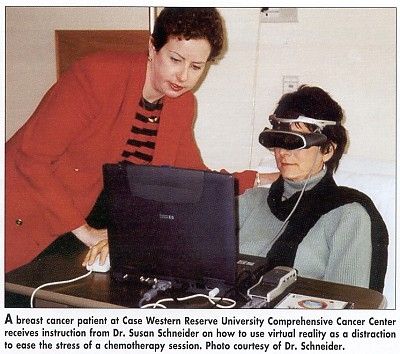Virtual Reality Distraction Eases Symptoms of Chemotherapy
PONTE VEDRA BEACH, Fla-Breast cancer patients were less stressed by treatment-related symptoms when they used virtual reality software to solve a mystery, visit an art museum, or go deep-sea diving during chemotherapy sessions. Susan M. Schneider, PhD, RN, AOCN, reported the results of the pilot study at the Oncology Nursing Society’s Sixth National Conference on Cancer Nursing Research.
PONTE VEDRA BEACH, FlaBreast cancer patients were less stressed by treatment-related symptoms when they used virtual reality software to solve a mystery, visit an art museum, or go deep-sea diving during chemotherapy sessions. Susan M. Schneider, PhD, RN, AOCN, reported the results of the pilot study at the Oncology Nursing Society’s Sixth National Conference on Cancer Nursing Research.
Dr. Schneider said that the patients showed significant improvement in the Symptom Distress Scale and the Piper Fatigue Scale immediately after the chemotherapy sessions with the virtual reality intervention, compared with sessions without the distraction.
While 48-hour follow-up did not reveal significant changes, the researchers noted a trend toward improved symptom distress, she said. The experiment also quelled fears that the virtual reality experience itself would produce symptoms such as headache and nausea.
The researchers turned to commercially available 3D CD-ROM software because it has been shown to help children and adolescents take their minds off cancer treatment.
"The stress of worrying about chemotherapy treatment can be exhausting," said Dr. Schneider, director, Graduate Oncology Nursing Program, Duke University. Patients often magnify their anxiety by fixating on the dripping of their medication and worrying about nurses going in and out of the room, she said.
Twenty women, ages 18 to 55, took part in the study at Case Western Reserve University Comprehensive Cancer Center, Cleveland. Each was evaluated twice: once after undergoing a chemotherapy treatment with a virtual reality distraction and once following a session with no distraction intervention.
The women wore a $2,000 Sony Glasstron headset that blocked out peripheral vision, restricting their view of the treatment room during chemotherapy (see Figure). The headset was connected to a personal computer, and researchers offered a choice of three commercially available CD-ROMs.

Titanic: Adventure Out of Time was the most popular. Thirteen women attempted to solve a shipboard mystery by querying fictional characters; they viewed the CD-ROM for 67 minutes on average. Ten women toured an art museum in A World of Art for 42 minutes on average. Six women took a virtual deep-sea dive in Oceans Below, for 31 minutes on average. (The total adds up to more than 20 women because some switched CD-ROMs during treatment.)
Time Flies . . .
Virtual reality seemed to make chemotherapy go faster. The patients estimated that 40 minutes had passed on average instead of more than 60. The women were unanimous that chemotherapy went better with the diversion, and almost all said they would try it again.
The American Cancer Society and the Comprehensive Cancer Center at Case Western funded the experiment. Dr. Schneider said she hopes to do a full clinical trial comparing different types of distractions, including books and music, with more breast cancer patients and a larger age range. Co-author of the study was Maryjo Prince-Paul, MSN, RN, CRNH, Case Western Reserve University Comprehensive Cancer Center.